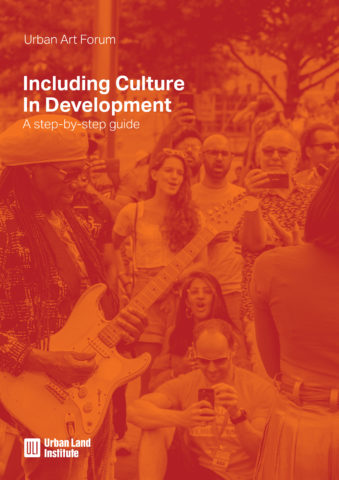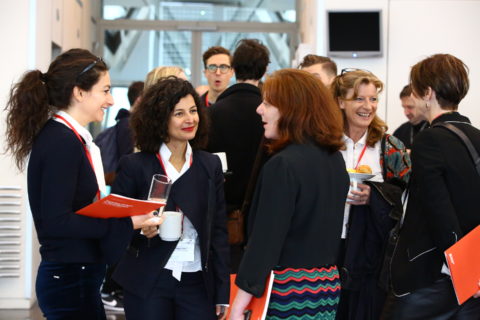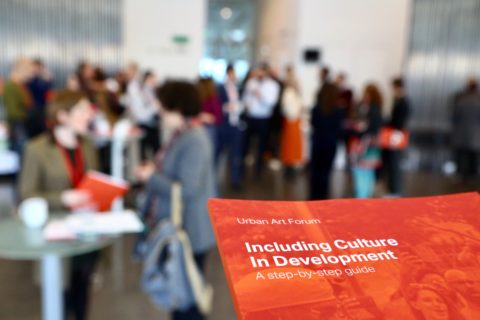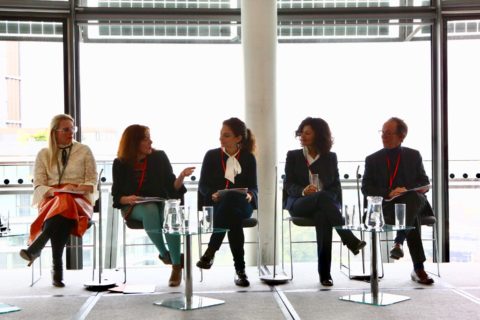Top Story
Event Recap: ULI Young Leaders Lunch and Learn with James Jacobs, Lazard
The ULI UK Young Leaders were lucky to have the opportunity to hear from James Jacobs, Lazard
23 October 2019

Cover of Including Culture In Development
The Urban Land Institute UK’s Urban Art Forum (UAF) has released its first publication, Including Culture in Development: A Step-by-Step Guide, following more than six months of research and development. Cultural placemaking has become a vital element for successful developments and is crucial for generating long-term economic and social return on capital investment. The guide provides clear and concise direction, along with effective methodology, and assists developers of the built environment to help improve the creation and integration of quality public art and cultural infrastructure within their schemes.
The step-by-step guide has been initially released as a London-focused publication, using case studies such as Somerset House Studios, the Creative Land Trust and Art Night along with select interviews – expanding on existing material such as the Greater London Authority’s ’Cultural Infrastructure Toolbox’. It establishes a methodology for best practice by identifying opportunities, goals, strategies and outputs for approaching a variety of factors such as timescale and intervention type.
By highlighting the objectives and roles within a particular project – those related to developers, cultural professionals, local authorities, local communities or design professionals – it provides a much-needed framework for developers and investors that highlights the benefits of incorporating cultural infrastructure and public art into their schemes.
The guide has been compiled with contributions from a range of highly-experienced culture and built environment professionals, including the Culture and Creative Industries Unit at the Greater London Authority, PLP Architecture, Futurecity, Sound Diplomacy, Contemporary Art Society and Launch Pad.
The guide will soon be available to all ULI members on Knowledge Finder – we will update this page as soon as it is online.
(Please note this is a free reduced version without case studies. For the full version, please click the links below).

Event Attendees

ULI UK Urban Art Forum “Including Culture in Development – A Step by Step Guide”.

Speaker Panel
Justine Simons OBE, Deputy Mayor for Culture and the Creative Industries
‘Culture and heritage are in London’s DNA. They are central to the success of our city and the reason people come here to live, work and play. It’s vital that culture is at the forefront of developers’ thinking and this guide will ensure that cultural facilities and workspaces remain a key part of the fabric of our city.’
Christopher Choa, ULI Global Governing Trustee
‘Public spaces democratise our cities. Urban art intensifies and amplifies our shared experiences in cities and expresses commitment to civic value – it shares a cultural benefit. The best urban art goes even further; it leaps to our senses and brings us closer to everyone who shares our experience.’
Hala El Akl, ULI UK Urban Art Forum Chair and Director at PLP Architecture / PLP Labs
‘This new publication empowers developers, local communities and cultural professionals with a holistic guide that will help them create projects that enhance local identity whilst also strengthening London’s reputation as a world leader in arts and culture. It establishes an approachable, step-by-step methodology for the inclusion of relevant, meaningful cultural elements in projects of all uses and sizes that consider impact from social, environmental and economic perspectives.’
Juanita Hardy, Creative Placemaking Consultant and formerly, ULI Senior Visiting Fellow for Creative Placemaking
‘Including Culture in Development is a concise, step-by-step approach, tailored for real estate developers, on how to do creative placemaking well. It highlights how successful projects employ best practices, such as engagement of artists/creatives and the community, and the formulation of strategic partnerships, early, during the design phase.
This guide delivers fresh thinking about project vision, stakeholder roles, and project outcomes. It makes a compelling case that creative placemaking, or art/cultural outputs, integrated into the project plan, can help to optimise ROI…by delivering not just economic, but enhanced social, health, and environmental outcomes and more, from which all stakeholders benefit.’
Sherry Dobbin, Futurecity
‘Great developers and artists share a taste for risk and ambition; both know that a strong vision and clearly identified objectives help excite and engage people. As artists enjoy situations that are complex, require investigation and finding an unexpected solution, this guide helps to align development challenges as opportunities and establish shared measures of success.’
Fabienne Nicolas, Contemporary Art Society
‘Culture is increasingly central to the development of our cities – shaping identity, creating dynamic experiences of place and fostering community building. And those who design, build and regenerate our cities are now key agents in generating culture. There is no one single definition of culture – it is dynamic and evolving, shaped by communities and responsive to place and context, and it is no wonder that the culture question can be a challenging one. This publication provides illumination and guidance –alongside great success stories – to help the custodians of our cities address the role of culture. It is one step – but an important one, to developing a shared vision and drive the development of our cities as global cultural powerhouses.’
Sarah Elson, Launch Pad
‘Artists, commissioners and developers play an incredibly important role in how cities – and all of us living in them – are shaped. Through interviews with members of these teams, and case studies selected for their diversity of outcomes, this guide gives a 360-degree view of best practices. It gives the reader the tools for identifying the different assets and objectives of each stakeholder and demonstrates how these can be harnessed and realised in successful and exciting ways.’
Shain Shapiro, Sound Diplomacy
‘It was a privilege to be part of the team who worked on this landmark guide by the ULI. Our arts and culture are what make places worth living in. This includes our music scenes of all genres and disciplines and our night-time economy. This guide is broad, yet descriptive and incredibly detailed in providing the tools for developers and local authorities to focus on, and champion, the arts and culture of their places.’
Don’t have an account? Sign up for a ULI guest account.

Event Attendees

ULI UK Urban Art Forum “Including Culture in Development – A Step by Step Guide”.

Speaker Panel